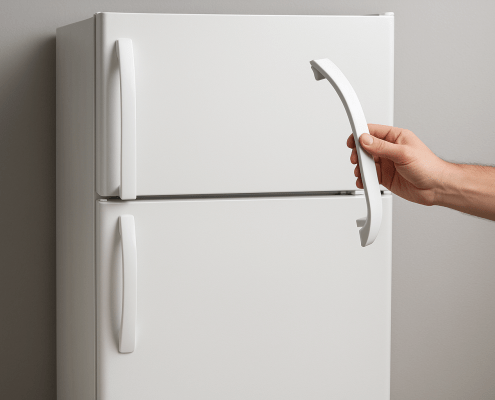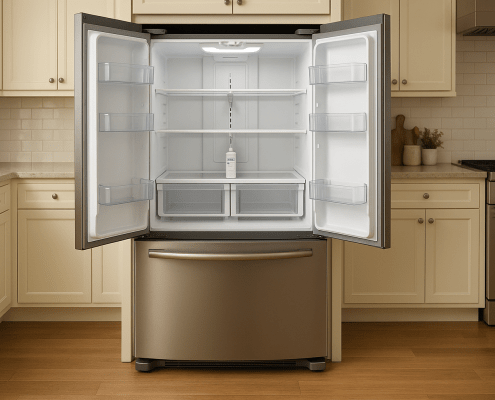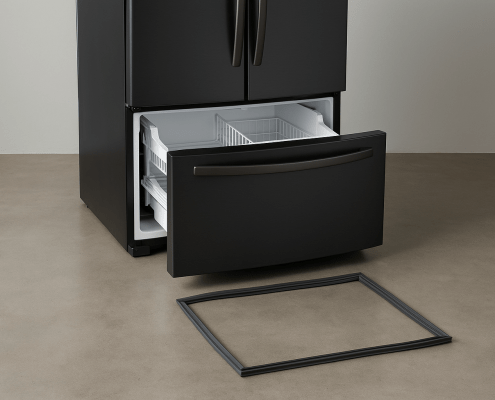How to replace GE refrigerator ice maker water line fitting WR02X10967
Steven E / Thursday March 7, 2024
Is your GE refrigerator’s ice maker turning your floors into a splash zone with unwanted leaks? A faulty ice maker water line fitting may be the culprit, but worry not—solution is at hand! Dive into our expert guide below, complete with a step-by-step video tutorial, to master the DIY fix and keep your ice maker running smoothly.
If the ice maker in your GE refrigerator is leaking water or you’re seeing more moisture than usual in that area, you might have a bad ice maker water line fitting.
The ice maker water line fitting connects the water supply line to the ice maker and allows it to fill with water. But over time, the fitting can become worn or damaged, resulting in leaks and preventing ice from being made.
This repair is relatively straightforward and should only take a few minutes. You can find a replacement ice maker water line fitting WR02X10967 here. If you need other replacement parts for your GE fridge, just enter your model number at AppliancePartsPros.com to find them. It’s that easy! Most orders arrive in just two business days, and we have thousands of guides to show you how to install your new parts.
Watch here: How To Replace: GE Refrigerator Ice Maker Water Line Fitting WR02X10967
What you need
- Needle nose pliers
- Putty knife or flat blade
- Screwdriver
- Towels or rags
- Replacement GE ice maker water line fitting WR02X10967 (make sure it’s compatible with your specific model)
Safety precautions
When working on any appliance, remember to keep safety first. Here are some tips to keep in mind:
- Always power off and unplug your appliance or switch off the circuit breaker before you attempt any maintenance or replacement work. This keeps you safe by preventing any risk of electric shock.
- Turn off the water supply at the outlet before beginning repairs. Keep towels ready to catch any residual water in the system when removing parts.
- If the appliance has recently been used, give it plenty of time to cool down before working on it.
- Take your time while working to prevent accidents and personal injuries. Rushing is the enemy of precision.
- Work in a well-lit area so you can clearly see and access appliance parts.
- Keep your workspace free of clutter and other obstacles. Keep children and pets away from the work area.
- Never work on internal parts with wet hands. Make sure the work area is completely dry.
- Check the user manual to see if there are specific installation or safety instructions related to your appliance or replacement part.
- Be gentle when handling or removing parts. Excessive force might damage the appliance or cause personal injury.
- Wear insulated work gloves to protect your hands from sharp metal parts and debris.
- When working with wires, avoid touching any exposed wires or terminals. If you need to touch a wire, use a non-conductive tool or wear insulating gloves to prevent electrical shock.
Check part compatibility
Before you replace the ice maker water line fitting, make sure you have an OEM part that’s compatible with your specific fridge model. To do this, you’ll need to find the appliance model number.
The model number will say MOD or Model before the numbers and is typically found on a sticker or a metal plate in one of the following locations:
- Inside the refrigerator, either on the side wall or the ceiling
- On the back of the refrigerator, near the bottom
- On the side or bottom of the refrigerator door
Once you’ve found the model number, write it down or take a clear photo of it for reference.
Next, visit AppliancePartsPros.com, where you can enter your model number to check if the new water line fitting is compatible with your model.
Read more: How To Find Your Appliance’s Model Number
How to replace the ice maker water line fitting
Step 1 – Remove the old water line fitting
- Turn off the ice maker and fridge.
- Unplug the fridge and turn off the water supply at the outlet.
- Find the ice maker water line fitting at the back of the refrigerator in the upper right corner. This fitting connects the water inlet line to the ice maker inlet tube.
- Use needle-nose pliers to squeeze the clip on the existing water line fitting.
- Slide the clip down to release it from the fitting.
- Pull the water line out of the fitting.
- Use a putty knife to free the fitting from the surface of the refrigerator. It may be glued in place.
- Use a putty knife to cut off the glue attached to the old fitting and pull it out.
Step 2 – Install the new water line fitting
- Peel off any protective layer of paper on the new ice maker water line fitting to expose the glue. Don’t touch the adhesive side of the fitting.
- Install the new fitting in the same location where the old fitting was removed. Make sure the opening is completely covered by the new fitting and push it in.
- Allow the glue to set and secure the fitting.
- Push the new water line into the fitting.
- Place the clip that was removed earlier over the tube of the water line.
- Use pliers to squeeze the clip.
- Plug the refrigerator back in and turn on the water supply and ice maker.
- Make sure the fridge and ice maker are working correctly.
Read more: How To Prevent And Fix A Frozen Refrigerator Water Line
Additional information
Thanks for reading! We hope this article helped you replace the ice maker water line fitting on your GE refrigerator.
If you still need some replacement parts, grab your model number and head over to AppliancePartsPros.com. We have over two million parts in stock and most orders arrive in two business days. If you need some help with finding the right part or placing an order, you can contact our team at 1 (877) 477-7278.
While you’re waiting for your new part to arrive, you can explore our DIY blog and watch thousands of video tutorials on our YouTube channel. We can also help you troubleshoot common fridge problems here.
Follow us on Facebook, Twitter and Instagram to see our latest repair guides!
With nearly a decade of experience in providing top-notch customer service regarding appliance parts and repair, Steven enjoys sharing practical advice, troubleshooting tips, and interesting information to help readers stay informed.





